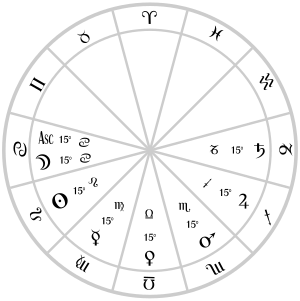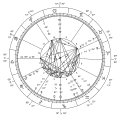Astrology is a range of divinatory practices, recognized as pseudoscientific since the 18th century, that propose that information about human affairs and terrestrial events may be discerned by studying the apparent positions of celestial objects. Different cultures have employed forms of astrology since at least the 2nd millennium BCE, these practices having originated in calendrical systems used to predict seasonal shifts and to interpret celestial cycles as signs of divine communications. Most, if not all, cultures have attached importance to what they observed in the sky, and some—such as the Hindus, Chinese, and the Maya—developed elaborate systems for predicting terrestrial events from celestial observations. Western astrology, one of the oldest astrological systems still in use, can trace its roots to 19th–17th century BCE Mesopotamia, from where it spread to Ancient Greece, Rome, the Islamic world, and eventually Central and Western Europe. Contemporary Western astrology is often associated with systems of horoscopes that purport to explain aspects of a person's personality and predict significant events in their lives based on the positions of celestial objects; the majority of professional astrologers rely on such systems.

The zodiac is a belt-shaped region of the sky that extends approximately 8° north and south of the ecliptic, the apparent path of the Sun across the celestial sphere over the course of the year. Also within this zodiac belt appear the Moon and the brightest planets, along their orbital planes. The zodiac is divided along the ecliptic into 12 equal parts ("signs"), each occupying 30° of celestial longitude. These signs roughly correspond to the astronomical constellations with the following modern names: Aries, Taurus, Gemini, Cancer, Leo, Virgo, Libra, Scorpio, Sagittarius, Capricorn, Aquarius, and Pisces.
Julius Firmicus Maternus was a Roman Latin writer and astrologer, who received a pagan classical education that made him conversant with Greek; he lived in the reign of Constantine I and his successors. His triple career made him a public advocate, an astrologer and finally a Christian apologist. The explicit, or end-tag, of the sole surviving manuscript of his De errore profanarum religionum gives his name as Iulius Firmicus Maternus V C, identifying him as a vir clarissimus and a member of the senatorial class. He was also author of the most extensive surviving text of Roman astrology, Matheseos libri octo written around 334–337. Manuscripts of this work identify him as "the younger" (iunior) or "the Sicilian" (Siculus). The lunar crater Firmicus was named in his honour.

The Hermetica are texts attributed to the legendary Hellenistic figure Hermes Trismegistus, a syncretic combination of the Greek god Hermes and the Egyptian god Thoth. These texts may vary widely in content and purpose, but by modern convention are usually subdivided into two main categories, the "technical" and "religio-philosophical" Hermetica.

In Western astrology, astrological signs are the twelve 30-degree sectors that make up Earth's 360-degree orbit around the Sun. The signs enumerate from the first day of spring, known as the First Point of Aries, which is the vernal equinox. The astrological signs are Aries, Taurus, Gemini, Cancer, Leo, Virgo, Libra, Scorpio, Sagittarius, Capricorn, Aquarius, and Pisces. The Western zodiac originated in Babylonian astrology, and was later influenced by the Hellenistic culture. Each sign was named after a constellation the sun annually moved through while crossing the sky. This observation is emphasized in the simplified and popular sun sign astrology. Over the centuries, Western astrology's zodiacal divisions have shifted out of alignment with the constellations they were named after by axial precession of the Earth while Hindu astrology measurements correct for this shifting. Astrology was developed in Chinese and Tibetan cultures as well but these astrologies are not based upon the zodiac but deal with the whole sky.
Astrological belief in correspondences between celestial observations and terrestrial events have influenced various aspects of human history, including world-views, language and many elements of social culture.
Astrology and astronomy were archaically treated together, but gradually distinguished through the Late Middle Ages into the Age of Reason. Developments in 17th century philosophy resulted in astrology and astronomy operating as independent pursuits by the 18th century.
An astrological age is a time period which, according to astrology, parallels major changes in the development of human society, culture, history, and politics. There are twelve astrological ages corresponding to the twelve zodiacal signs in western astrology. One cycle of the twelve astrological ages is called a Great Year, comprising 25,772 solar years, at the end of which another cycle begins.

In astrology, exaltation is one of the five essential dignities of a planet. The exaltation is a place of awareness for the planet, whereas the fall is a position of weakness concerning the function of the planet.
Essential dignity, in the context of an astrological horoscope or natal chart, refers to the relative “strength” or “weakness” of a planet based on its zodiac sign and specific degree. This strength or weakness is referred to as the planet’s essence—what the 17th-century astrologer William Lilly called "the strength, fortitude or debility of the Planets [or] significators."

The decans are 36 groups of stars used in the ancient Egyptian astronomy to conveniently divide the 360 degree ecliptic into 36 parts of 10 degrees each, both for theurgical and heliacal horological purposes. The decans each appeared, geocentrically, to rise consecutively on the horizon throughout each daily Earth rotation. The rising of each decan marked the beginning of a new decanal "hour" of the night for the ancient Egyptians, and they were used as a sidereal star clock beginning by at least the 9th or 10th Dynasty.
Dorotheus of Sidon was a 1st-century Greek astrologer and astrological poet, who, during the Hellenistic Period, wrote a didactic poem on horoscopic astrology in Greek, known as the Pentateuch. The Pentateuch, which was a textbook on Hellenistic astrology, has come down to us mainly from an Arabic translation dating from around 800 AD carried out by Omar Tiberiades. The Arabic text, however, does contain interpolations by later Persian hands, but, nevertheless, remains one of our best sources for the practice of astrology during Hellenistic and Roman times, and it was a work of great influence on later Christian, Persian, Arab and medieval astrologers. The late 1st century, a time when Dorotheus is believed to have flourished, was a period of intense astrological development, following two millennia of accumulated tradition.
Vettius Valens was a 2nd-century Hellenistic astrologer, a somewhat younger contemporary of Claudius Ptolemy.
Antiochus of Athens was an influential Hellenistic astrologer who flourished sometime between the late 1st and mid 2nd century AD. There is some disagreement as to when he lived and wrote. Franz Cumont and others have argued that he lived as early as the 1st century BC, while David Pingree placed him as late as the end of the 2nd century AD. The one agreed datum is that Antiochus is referenced by Porphyry, and so Antiochus must have lived before the death of Porphyry.

Babylonian astronomy was the study or recording of celestial objects during the early history of Mesopotamia. The numeral system used, sexagesimal, was based on sixty, as opposed to ten in the modern decimal system. This system simplified the calculating and recording of unusually great and small numbers.
Often called lunar mansion, a lunar station or lunar house is a segment of the ecliptic through which the Moon passes in its orbit around the Earth. The concept was used by several ancient cultures as part of their calendrical system.

Egyptian astronomy began in prehistoric times, in the Predynastic Period. In the 5th millennium BCE, the stone circles at Nabta Playa may have made use of astronomical alignments. By the time the historical Dynastic Period began in the 3rd millennium BCE, the 365 day period of the Egyptian calendar was already in use, and the observation of stars was important in determining the annual flooding of the Nile.
Teucer of Babylon was an ancient Egyptian astrologer of uncertain date, though likely in or before the first century AD. David Pingree concluded that he is used as a source by Vettius Valens and Rhetorius, which dates him to at least the first century AD, while Wolfgang Hübner argues Marcus Manilius and Julius Firmicus Maternus drew on some of his materials, dating him to at least the first century BC. Teucer is mentioned by the philosopher Porphyry, which places him definitively before the third century AD.

Dodecatemoria are subdivisions of the twelve signs of the Zodiac into a further twelve parts each. These can be said to form a "micro-zodiac" of 144 dodecatemoria, each corresponding to 2.5° of the ecliptic. In an alternate usage, the dodecamorion refers to a point on the ecliptic reached by the addition of twelve times a given number of degrees within a sign, either to the original degree, or to the beginning of the sign.












